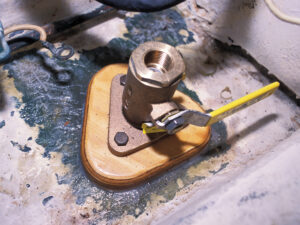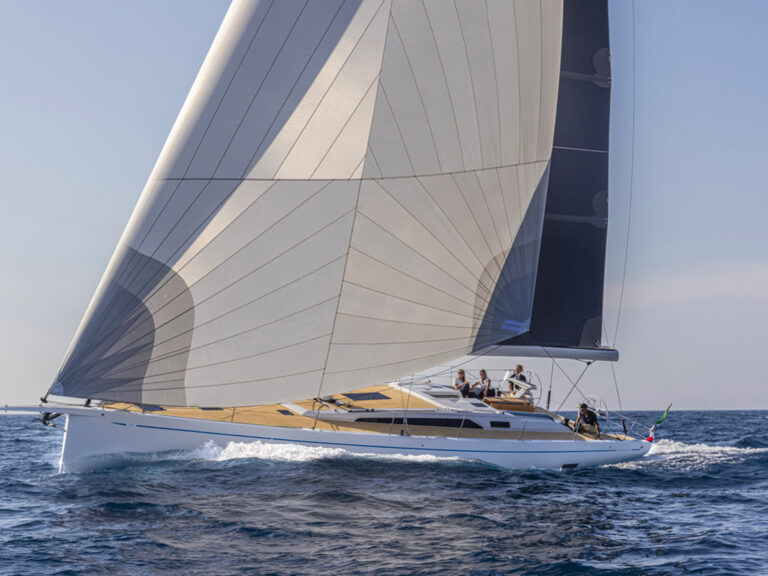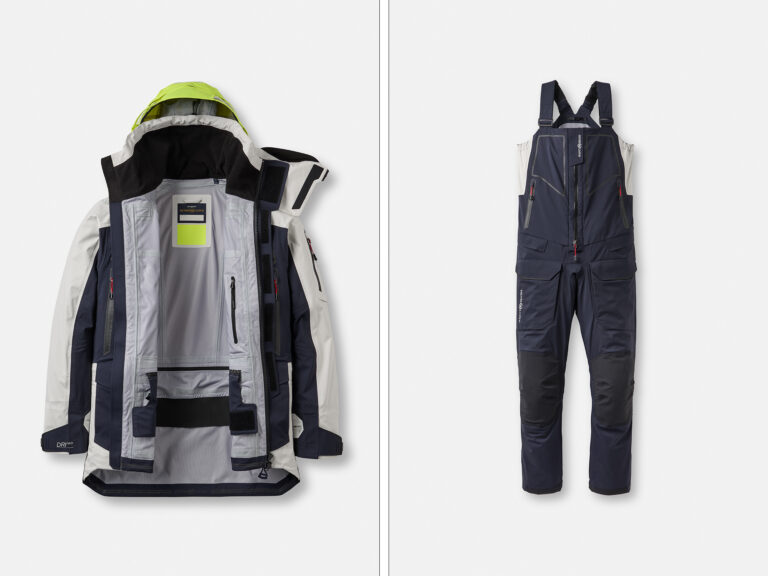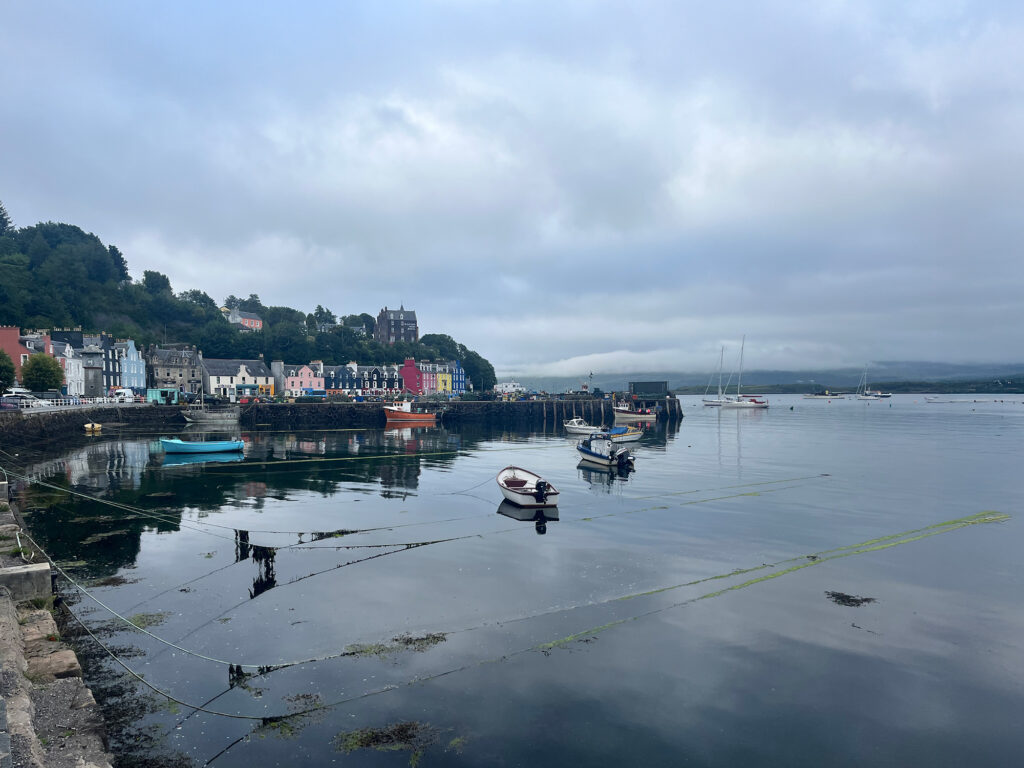
Emerging from the mist like a craggy apparition, the sheer cliffs fronting the Scottish isle of Skye dramatically revealed themselves. We were motor-sailing aboard the Swan 68 Aphrodite from the nearby island of Rum, one of the so-called Small Isles of the country’s Inner Hebrides chain, and we’d already been forewarned that the coast of Skye would be scenic and remarkable. Now, here it was, in all its noble glory. And it was clear that the coming attractions had been spot-on.
Tall granite peaks stood proudly against the sea. Rivulets of water spilled over the lofty plateaus until the spray coalesced into riveting waterfalls, one after the next. At sea level, along the weathered shore, relentless storms with accompanying seas had battered the coastline, as evidenced by the deep caves. Seabirds wheeled overhead in one direction, as a pod of dolphins trucked along in the other, their fins rising and submerging in unison. It looked like a scene from a movie.
Eventually, the hard rock began to slope off. It gave way to patches of green hills. Still high aloft, the white dots spotted among the emerald bits were slowly stirring. As always in Scotland: sheep and more sheep.
I’d been sailing with skipper Murray Jacob for more than a month now, starting with a transatlantic voyage from Rhode Island to Ireland before we’d delivered Aphrodite north to Scotland. As usual, the captain was quick with a comment. “If there’s a sheep Olympics,” he said, “those ones win some medals.”

Scotland was proving an exceptional cruising ground. And we were exploring these enchanting waters with a rather remarkable assemblage of like-minded sailors, which made it even better.
Four days earlier, we’d left the Scottish island of Kerrera on the so-called “Western Isles Cruise 2025,” a movable feast of 50-some yachts representing a half dozen sailing organizations: the Cruising Club of America; the Irish Cruising Club; Scotland’s Clyde Cruising Club and Royal Highland Yacht Club; the Royal Cruising Club from England; and the international Ocean Cruising Club. Aphrodite, owned by former CCA commodore Chris Otorowski and his wife, Shawn, was one of a handful of boats representing the CCA; like our seaworthy Swan, several had crossed the Atlantic to join the festivities. (Unfortunately, the Otorowskis were unable to attend, but they gave us the green light to set sail in their absence.)
It had all commenced from the cool Kerrera Marina, a full-service, family-owned operation that’s a short hop across the water from the bustling town of Oban, a popular destination for tourists thanks to its plentiful fresh seafood, colorful Victorian architecture and never-ending fleet of ferries servicing the nearby Hebridean islands. The marina was not only an ideal headquarters for the cruise, but one with important historical significance. During World War II, it was the site of the Royal Air Force’s Oban Airfield flying-boat base, and the ramp for the marina’s current Travelift was once used to extract seaplanes for maintenance.
Kerrara Marina also served as the host for the CCA’s meet-and-greet party, with boat sheds and support buildings transformed into dining halls for a sumptuous buffet for the dozens of participating sailors. It was there that we met our Scottish buddy boat for the cruise, skipper Ken Andrew’s 38-foot Argento representing the Clyde Cruising Club. It was a huge stroke of luck, for the Argento lads provided plenty of local knowledge in equal measure with hearty laughs and endless drams of good Scotch whiskey.
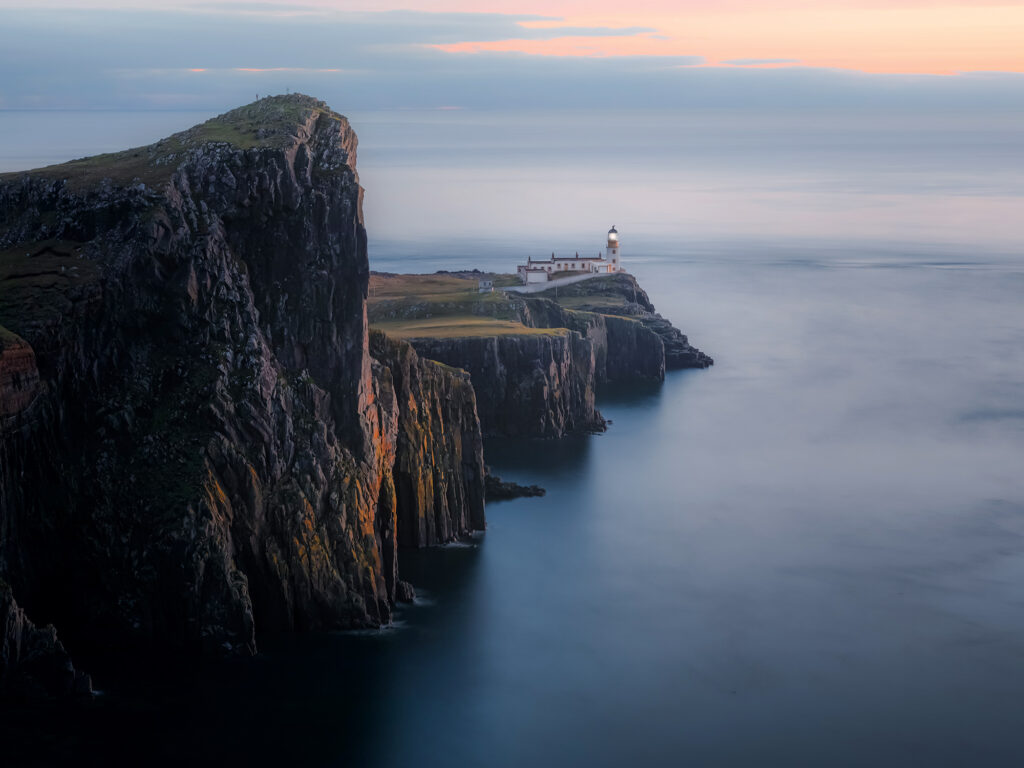
With that we were off, bound for the port town of Tobermory in what was, for most of the fleet, a 35-nautical-mile race. For Aphrodite and crew—Murray, myself, CCA members and seasoned sailors Peter and Adrianne Becker, and Spike Lobdell and Betsy Bowman—it was a rather cruisy jaunt, as we were towing a big tender to facilitate future explorations. Tobermory was a salty, pretty little place with fine pubs adorning the waterfront, and an ideal first stop.
Thick fog engulfed the harbor the next morning as we prepared to motor to the protected waters of Loch Drambuie for one of the cruise’s signature moments: the Sunflower Raft organized by the Royal Cruising Club. As the fleet’s largest yacht, Aphrodite had been designated as one of the eight “cardinal boats” around which the raft would be assembled. Capt. Murray was—how shall we put this—less than enthusiastic about this assignment (“If it’s windy, it’ll be a cluster”) but the RCC’s vice commodore, Tim Trafford, was a pillar of organization, directing a small fleet of RIBs, and it went off without a hitch. “The sunflower is complete!” he announced over the VHF radio as the last boat slipped into place and many a dram was poured. The breeze did kick in, but not until all was disassembled.
The next morning, we powered past the adjacent Small Isles of Muck and Eigg on our way to Rum, where we dropped the hook and had a good look around at the nature reserve, camps and general store before the swarms of biting midges had us scurrying back to the boat. From there, the next day, it was on to Skye and its jaw-dropping visuals.
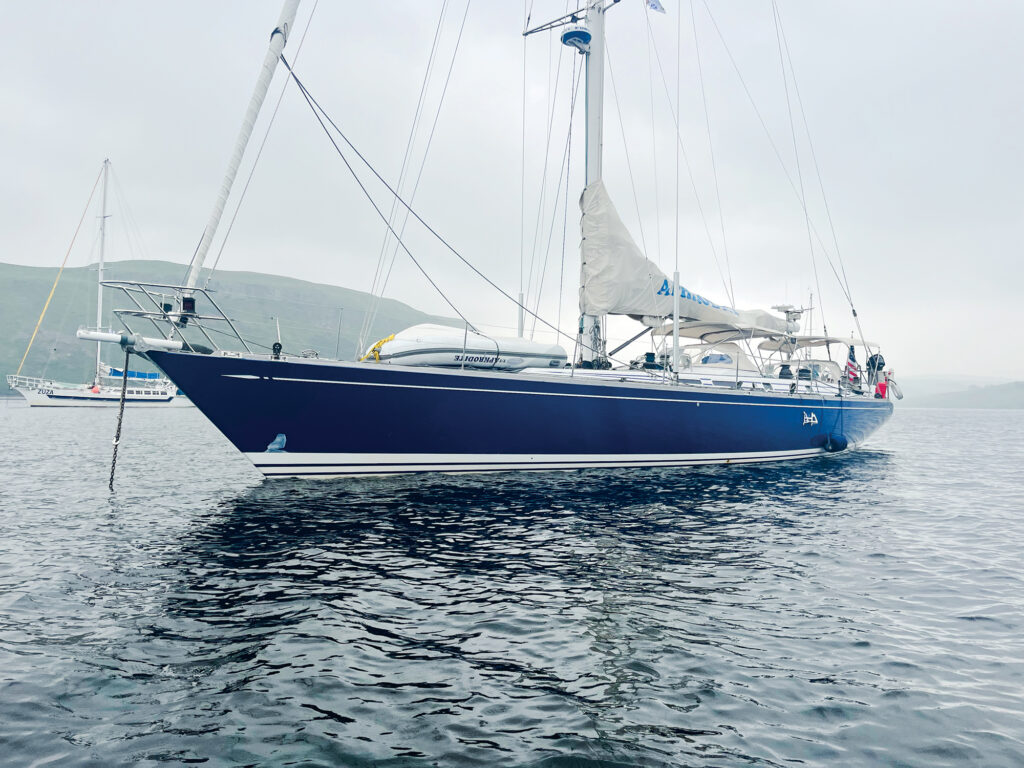
What had really drawn us to Skye, however, wasn’t the arresting scenery but the Talisker Distillery on the shores of Loch Harport, with a tasting and lunch organized by the Irish Cruising Club. The distillery has been in operation, so the story goes, since 1830, wwhen the MacAskill brothers rowed in from Eigg and set up shop: “Made By the Sea” is its fitting slogan. I was never much of a Scotch drinker, but I enjoyed the tour and was definitely acquiring a taste for it. My favorite part (other than dodging the flocks of sheep meandering down the road) were the plump, incredibly tasty oysters (adorned with a “mist” of Scotch) served up in Talisker’s restaurant afterward. I put away more than a few.
The distillery tour was one of several organized events scheduled every few days over the course of the cruise’s two-week itinerary. They were all quite social affairs. I was enjoying getting to know the CCA crew, including current Commodore Jay Gowell, who was sailing his Tayana 52, Moonstone. I’m not a CCA member but have many friends who are, and I’ve always admired their guiding motto and spirited raison d’etre: “Adventurous use of the seas.” It was fantastic sailing in company with this group, all excellent sailors and just terrific, friendly folks.
From Skye, the next highly anticipated stop would be the Outer Hebrides chain, dead to windward. Accomplished offshore sailor Peter Becker made an astute call when he dubbed our masthead windex the DDD: the “Delivery Direction Indicator,” the maxim that states the wind always blows from the direction we wish to go. It did turn into an upwind bash, but Aphrodite is a powerful beast sailing to weather, and we crossed the Sea of Hebrides in a pretty ideal 15 to 25 knots of fluctuating southwest breeze.
We spent our first night anchored off the isle of South Uist, just outside the very complete facilities at Lochboisdale Harbour, which is billed as “the ideal point of entry for visitors to the Hebrides.” It was a raw, wild place: barren, rocky, scrubbed. (With, of course, many sheep.) “This,” Murray said, “is what I thought Scotland would look like.”
Heading south the next day under a double-reefed main in continuing solid breeze and rather appalling weather (which is pretty much what I thought Scotland would look like), we made our way to the island of Barra, a virtual metropolis in these parts with a population of 1,300 rugged souls. The highlight here (other than the palm trees swaying in the small gale, a testament to the range and reach of the Gulf Stream) was dinner in the warm, cozy confines of the dining room at the Castlebay Hotel. More specifically, it was the steaming bowl of Cullen skink, a creamy chowder full of smoked haddock, potatoes and onions that was delicious. If ever a meal were suited to the place and the moment, it was Cullen skink.
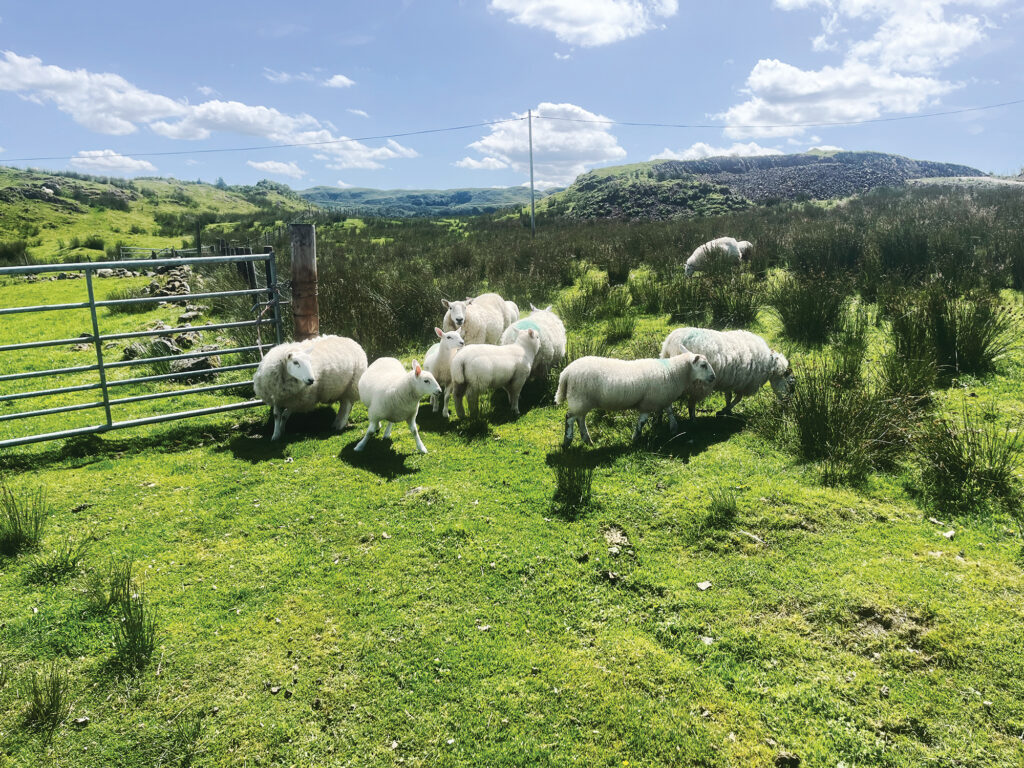
It was a quick motor from Barra to the isle of Vatersay, the southernmost and westernmost inhabited island in the Outer Hebrides. A supper at the local community center was the day’s organized event, with a terrific, youthful band of bagpipers who infused the proceedings with a Scottish accent. The pristine twin beaches to either side of a spit of land adjacent to the community center were truly spectacular. The eastern beach was at the head of the protected bay that served as the main anchorage for the rendezvous. The western beach, just a short walk away and facing the blue Atlantic, is one I’ll not soon forget. There were wandering sheep, of course, but the big surprise were the cattle wading near the seashore. I stole away from dinner for a long, breathtaking walk. Other than the livestock, I was the only other sentient being around.
I’d have been perfectly happy spending the summer wandering these gorgeous Outer islands, but time waits for no cruise in company. In more ways than one, Vatersay had been the apex of our travels and the real turning point: It was time to start making our way back to Kerrera. But good times were still on the horizon. Some 70 miles back to the east, so was our next destination.
Our mates on Argenta knew of a pub called the Old Forge in the small village of Knoydart on the shores of a lake called Loch Nevis that was accessible only by boat (a 7-mile trip from the nearest port) or by foot (an 18-mile hike). Off we went. We had a couple of fine hours of sailing before the passage devolved into a long motor-sail, but it was all worth it. The loch was spectacular, and the locally brewed beer at the pub was fresh as could be. The only problem? It was a Monday, and no chow was being served. So, after a couple of rounds, we retired to Aphrodite with our friends. Dinner was whipped up, and more than one Scotch bottle was opened, its cap tossed away.
It was a fine night. The next morning? Less so. I can only speak for myself, but the day’s mission—a return sail to Tobermory—was a bit hazy, and I’d learned an important lesson. Never attempt to drink Scotch with the Scotsmen.
The cruise itinerary had one more item on the docket before the final party back in Kerrera—the Impromptu Alfresco Pot Luck Party—with a variety of possible lochs or ports as the venue. What transpired was unexpected and outstanding: a big gathering at the secluded Inverlussa Mussel Farm.
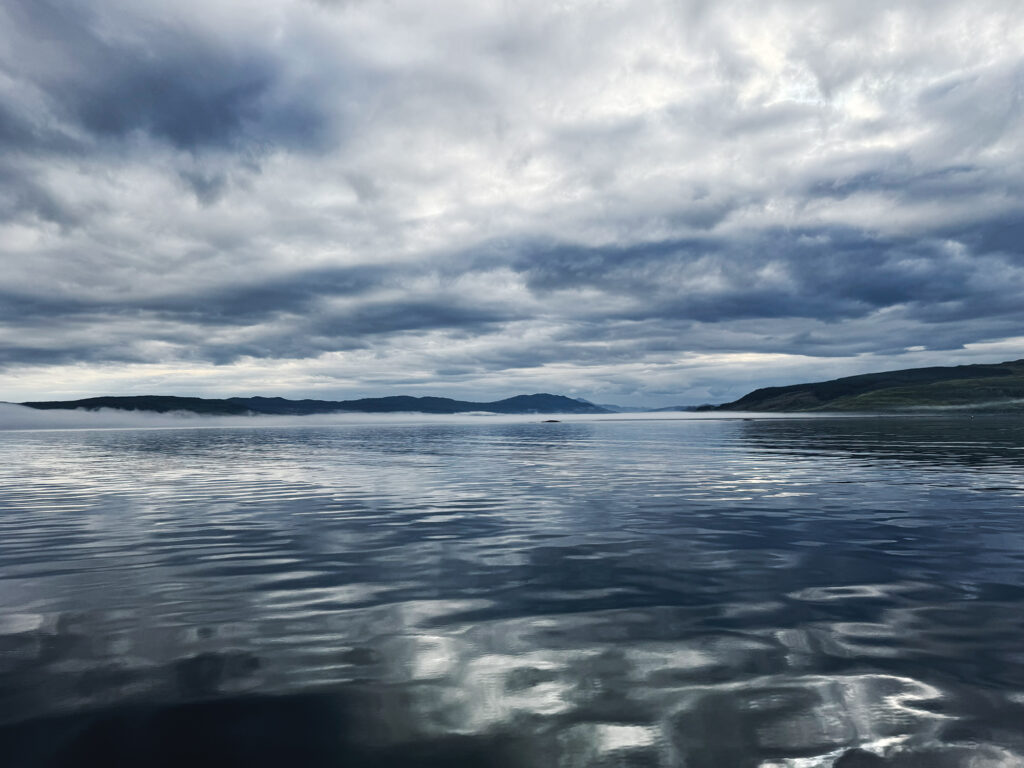
The current was piping along at better than 3 knots as we motored through the entrance to Loch Spelve on the isle of Mull and wended our way to the northernmost finger, where a big sign on the shoreside facility—“Moules”—clearly pronounced that we’d come to the right place. In exchange for donations to the Royal Life Saving Society, the outfit that patrols the waters of the U.K. to aid distressed mariners, the farm had donated a hundred pounds of prize mussels, which were absolutely out of this world. Every boat brought a dish and grog, and it all turned into a mighty feast. There’d be one celebratory party back at the marina to wrap things up, but as far as I was concerned, those moules were the journey’s exclamation point.
It had been a fantastic cruise, and I’d been honored to be part of it. Scotland is now firmly on my list of favorite cruising grounds. Great mates, whiskey, scenery, and on and on. Nothing but wondrous memories in the bank. Heck, I’ll even miss the sheep.




